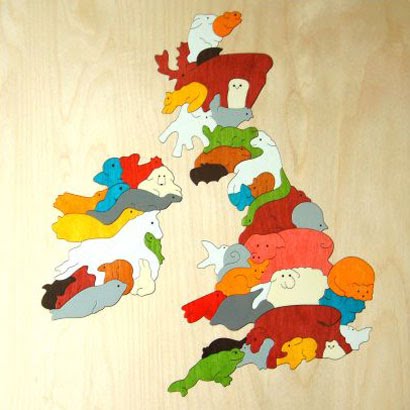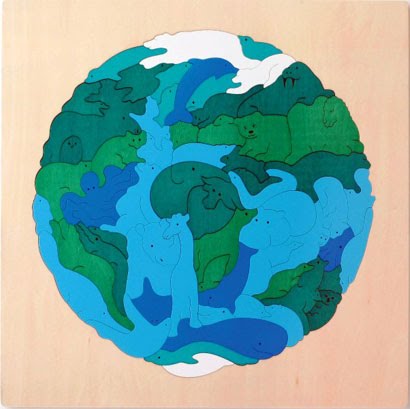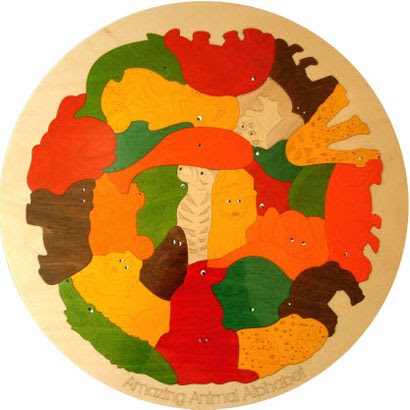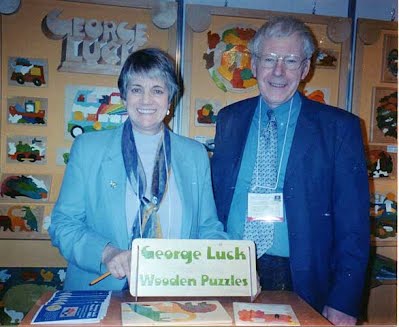George Luck (1943–) and Kay Luck (1943–), husband and wife, trading as George Luck Ltd, have a long history in operating as a children's jigsaw puzzle business, from 1974. The business can be described as of a substantial worldwide nature, with ventures in the UK, Germany, New Zealand and Japan, and can be described as a household name in children’s puzzles. There are about five hundred designs, albeit only a relatively few (eight) involve cluster puzzles. Indeed, the brand name continues to this day, although they themselves are no longer actively involved, having retired, emigrating from the UK to New Zealand in 2005, and sold the brand and copyright to the German company Hape, the world’s largest producer of wooden toys, in 2013. The puzzles are marketed on a wide variety of educational and children’s jigsaw puzzle websites worldwide. Plywood is the exclusive medium and cut using fine blades. On occasions, the boundaries are blurred as to cluster puzzle intention. One puzzle sometimes associated with them is a Noah’s Ark, and indeed, is marketed under their name. However, this more exactly is by Phillip Gell, of whom they were once associated. As a clear distinction is made, I thus omit this instance. As a general observation, the various cluster puzzles are not discussed in any great detail on any commercial outlet, in print or online, and so it is not an easy task to document. The sole focus is (not unexpectedly) on marketing. Indeed, the same lack of detail also applies to puzzle pages in general. An obvious beginning is to investigate their website. However, the website is now of this writing (2020) defunct. Previously (2016?) it was merely a legacy page, with minimal background details (a single page), stating that he has been making jigsaw puzzles for nearly forty years, and of which recently (2013) he has retired; no other detail of note or contact is given. However, upon making a more determined attempt to find him than previously, I eventually succeeded, in January 2017. Pleasingly, I found him, and Kay, expansive to a series of questions and queries, and of which the story can, to a large extent, now be told, and of which I show excerpted details below. Of their work as regards cluster puzzles, these are pleasingly themed, with eight unambiguous examples, of a country, continent or world theme, with native animals of the UK, Australia, Africa, China, North America, New Zealand, and the world. There is also another of a different premise, Amazing Animal Alphabet of 26 animals, with an animal for each letter of the alphabet. As a rule, these are quite good, albeit with the occasional inevitable contrived motif, with all the advantages (and difficulties thereof, and so more worthy of praise than of a more arbitrary collection, all things being equal) of a cohesive theme. World is very good, of which this shows the continents with what appears to be their respective native animals. As a simple description, the individual creatures can be described as simplified with minimal detail, of relatively high quality, of the higher standard, of true interlocking, of type A. In addition to the above, there is also another puzzle that can be considered as cluster puzzle in nature, Tree of Life, albeit in both subject matter and style is noticeably different, without such strict regard as to the tessellation principle. As an aside, country and continent themes can also be seen in the work of Ilaria Logi (Australia), Adam Laurance (Australia), and Anthony Prischl and Paul Gibbs (Africa and US) although likely the Lucks works precede all these save for possibly the Logis, but all are independent of each other. For the purchaser or the would-be collector, obtaining the puzzles is not a straightforward task as may otherwise be thought. In short, they are not marketed separately but rather included in Hape general range of Luck puzzles. And even then, there appear to be periods when they are unavailable. The same situation arises on eBay. In short, as of this writing, there are 325 results. It is tedious indeed to search through this to find, by chance, any of the cluster puzzles, and all without the guarantee of success. Be all as it may, the Amazing Animal Alphabet is more easily available for a general £30. A search on the term soon shows stockists. Given the lack of background detail, in the course of our correspondence, I asked the Lucks a series of detailed questions. Their replies were most illuminating, with much now previous uncertainty determined. Below I have assembled the more interesting comments, with minor omissions and editing in places for the sake of a better read. All dates are of 2017. DB 29 January (airmail letter) Were these (the concept) an independent innovation, or were you previously familiar with the genre, from Escher perhaps, or the famed Italian designer Enzo Mari? GL 29 January (email) This is the first time we have heard of "cluster puzzles". Tomorrow we will email you with a few more details and answers to your questions.
KL 30 January Re Philip Gell He worked as a graphic designer and the Ark was a hobby that took him three years in his spare time. We haven't heard from him for several years… Re Escher We'd done a couple of small designs, one of interlocking birds and another of fish and were showing them at a trade fair when this name was first mentioned. We'd never heard of him before. Re Map puzzles The idea of fitting animals into the map of Australia came from our Japanese distributor when we met at Nuremberg Fair. Re Logi and Plathy We didn't know of their work at all. It is extremely beautiful.
DB 30 January questions, KL answered 1 February DB Have any of your cluster puzzles appeared in print? If so, could you tell me the publication and date? KL The map puzzles have appeared in many catalogues and websites and were also in trade shows every year in London, Birmingham and Nuremberg. Luckily the map puzzles have never been copied exactly, unlike other designs of ours. The GB and Ireland map is pictured in the Tom Tyler book. The GB puzzle is a favourite of mine. Tom's is the only hard cover book that we know of. DB. The ‘revelation’ as to the map puzzles with ‘Japanese distributor’ is most interesting in many ways. In a sense, is he responsible for ‘all’ here? I.e. did he give you the idea, from which you then expanded from Australia to other countries? KL. The map idea was just a quick scribble on the back of an envelope by the Japanese distributor. Having produced the first one (which he liked) it made sense to do a series to get more sales from his company. They remained loyal customers for many years. Leismann, our German distributor at the time, also loved the style and quality of these. Both these nations have a tradition of top quality traditional toys. DB. Have any of the preliminary drawings survived? And if so, can I see one or two (or as many as you are comfortable sending)? To me, it is always interesting as to the design procedure; people have different methods. KL. I have the line drawings of all the map puzzles. I could send an image of the pencil drawing of the GB with scribbles round the outside, although it is rather grey in tones, more than b/w and might not make a sharp image. DB. I’m still a little unclear as to the designer. My interpretation is that Kay did the actual cluster puzzle designs, and you then did the cutting of the puzzles? Or was it a more or less equal collaboration of design and cutting wise? KL. I did most of the design work. It was easier this way as I could be in the house with the children when they were small. George is also artistic and gave helpful advice and guidance on subject matter, colour schemes and so on. We also tested the design ideas on our employees to get a reaction. When designing the map puzzles I would make a list of the indigenous and perhaps farm animals in order of importance. I would choose several large flowing animal shapes to make [an] impact and place them strategically, with regard to their colour. Others would be gradually fitted around these after I had sketched them in different positions. I had to consider the sequence in which the animals would be cut so that there was some flow to the cutting process as well as the lines of the design. Certain shapes had to be avoided as small children are good at testing the breaking point of puzzle pieces, particularly anything U shaped! Re cutting the map puzzle designs: at this stage we had trained about ten folk as cutters on our electric fretsaw machines. We could cut four puzzles at a time as they were taped together with the design printed on card and taped to the top. It was extremely skilled work as one false move or badly broken blade could ruin a lot of work. There were only a few of our cutters who were practiced enough to do this work. It was very, very rare that George or I cut the map puzzles as we were too busy involved in other aspects of the business. Only one or two could cut the Ark, as the lines were so straight. It is much easier to cut complicated puzzles by laser hence the proliferation of some of the new designs you've mentioned. DB. Thanks for the details on Phillip Gell. I have previously had a look for him to no avail. Can you add to what you have told me as to your interaction: did he approach you, or vice versa, and the circumstances thereof? KL. He approached us with the Ark puzzle and did a few other children's puzzles for us. The Ark was popular as a high-end example of our work. The others also were very clever designs but did not produce great sales as they tended to be more expensive to produce and didn't feature animals. We had a simple rule that to make a children's puzzle a success it needed an animal that should be familiar, friendly, furry/fluffy, funny. Philip was trained in graphic design and was quietly amused by our early and naive attempts at design. From this, it can be seen that the concept was of their own innovation, as has frequently happened with other designers. Each puzzle in detail Australia, 1992, 33 pieces Fig. 1. AustraliaEurope, 1992 * pieces [PLACEHOLDER - No picture available] Fig. 3. Europe Wild World, 1993, 56 pieces Fig. 4. Wild WorldUSA, 1994, * pieces [PLACEHOLDER - No picture available] Fig. 5. USA Amazing Animal Alphabet, 2002, 26 pieces Each of the 26 pieces, represents an animal, with the first letter of the animal on its base. The 26 letters make up the alphabet. An interesting feature here is the in-built rotation of the puzzle for the sake of convenience. Offhand, I do not recall seeing this elsewhere. As I have learned from Kay, there was a great deal of trial and error here, with changes made to the animals as the puzzle developed. Perhaps not evident from the puzzle alone is that this is based upon a spiral. She relates: Another shows the plan to work in a spiral. I wanted to avoid a very long puzzle and to divide it into lines to fit in a square would throw up the problem of expecting a young child to “read” the puzzle like a book. The spiral is L to R as that is easier for a right handed person. I had planned I for [an] Ibis (bird) which later became Ibex (a goat). The Koala became a Kangaroo, mother and baby, smiling to camera! You can see my thought process. Newt was impossible to do because the feet were too tricky in wood, so I chose Numbat (an Aussie creature). Parrot became Panda and Rabbit became Raccoon. I was trying to make it as international as possible. The Whale became much more dominant. Fig. 6. Amazing Animal Alphabet New Zealand, 2005, 43 pieces. A feature here is the use of whales around the periphery. Fig. 7. New ZealandAfrica Table of the Puzzles Of interest is an analysis of the more ‘vital aspects’ of the puzzles, in terms of the titles, number of pieces, the date, and see what can be extracted. To this end, I have thus compiled a table of these aspects. Some of the pictures I have are of too low a resolution to determine the number of pieces
Timeline (mostly from information provided by the Lucks) 1974 George designed and hand made the first puzzles for their children and then the local school. 1975 George quits his job as a medical representative to start making puzzles full time. Kay (an ex teacher) took over the design work. Many early puzzles were selected by the Design Centre, London, for their index. 1982 Design Award (presented by HRH the Duke of Edinburgh) for the whole range of puzzles. All puzzles were cut on electric jigsaws in their workshop of about 20 employees in Somerset, UK. 1992 Australia, Great Britain, and Europe puzzles. 1993 Wild World puzzle. 1994 USA puzzle. 2001 Purchased a laser cutter and designs were computerised. 2002 Amazing Animal Alphabet puzzle. Gold Award (National Association of Toy and Leisure Libraries) for a small range of children's puzzles. 2004 Christmas, stopped UK production. Production transferred to China. 2005 New Zealand puzzle. Migrated with their son to join their daughter and other family in New Zealand. 2006 Another Gold Award (NATLL). 2012 China puzzle. 2013 Sold copyright and brand name to Hape, a German company. Production is now set up in their own factory in China (not the same factory as previously) and this year they are relaunching a large range of puzzles at the major toy fairs retaining the name George Luck. Summary
As a broad, general sweeping statement, I find favour these, but they are not my favourites in terms of the inherent quality of the motifs, many of the pieces lack definition or on occasion are a little contrived; overall the puzzles are good, yes, but not outstanding. Of course, my critique here should be borne in mind with the premise of a child’s (fun) puzzle and not of an attempt at ‘high art’ by the designers, as well as the constraints imposed by the country and continent outlines. It is not easy! A pleasing aspect is a desire for cohesion, with every puzzle a theme; this desire thus elevates the puzzles as when compared to others which lack this feature. Also, they are designed as to the strictest standards of tessellation, without rounding off, or even worse gaps, of which in other people's work can be most pronounced. Picking a ‘best’ is not easy, they are all more or less of the same standard. Indeed, on this occasion, I refrain from doing so, as no one puzzle is markedly above another.
References As a general, catch-all statement, there are surprisingly few references in whatever medium! I am most surprised, given the prominence and worldwide distribution. Below I separate accordingly, as to books, articles and the web.
Books Somewhat surprisingly, there is very little mention in books, and what little there is, is largely in passing. The main authority of jigsaws, Anne Williams, does not mention Luck in either of her two defining books on the subject, Jigsaw Pieces and The Jigsaw Puzzle. However, in her Jigsaw Puzzles, the remit is both out of the date, 1850–1970, and not of USA origin, and so by default it would not appear there. The best, albeit still limited, reference, is in Tom Tyler’s British Jigsaw Puzzles of the 20th Century, albeit even here, the discussion is not particularly extensive, with a brief history. Around 1982, when the puzzles won an award in design circles, there is some discussion in design books, but from what I have seen, on Google books, this is still very much of a lightweight nature (the books are judged uneconomic to pursue in a variety of ways, of cost, time and of likely relative unimportance in the round). Tyler, Tom. British Jigsaw Puzzles of the 20th Century. Richard Dennis 1997. A brief history of the company, p. 36 (amid a general history of other companies). Mention in passing in regards to children's puzzles, p. 42. Great Britain map puzzle, p. 110, in the context of a page on ‘Puzzling Pictures’, with a caption only, no discussion. Mention in manufacturers, p. 128. Design, Issues 397-402, p. Xii, 1982 Minor reference, Google Books clipping, not all seen PUZZLES BY GEORGE LUCK Seven years ago, George Luck, then a sales representative selling ethical pharmaceuticals, made some wooden ... "The puzzles I made originally for my children were of pictures stuck to wood and then cut" explained George Luck. ... Subjects depicted range from pretty country cottages ... British Business, Volume 7, H.M. Stationery Office, 1982 The subjects range from pretty country cottages to whimsical drawings of children and are suitable for all kinds of occasions and age groups. Contact: ... Wooden puzzles originally made by George Luck to amuse his children won an award.
Articles Amazingly, I am unaware of even a single article! Surely there must be, but where?
Web Again, very little. Even from the manufacturer, Hape, there is little, and what there is, is nothing of any great substance. Aside from the manufacturer’s pages, I would have thought that some enthusiasts may have mentioned the puzzles, but even here, there is little.
Hape https://www.hape.com/uk/en/wooden-toys/george-luck-puzzle Oddly, the site does not show a single picture!
https://hapetoys.eu/en-gb/hape-george-luck-puzzle/?count=14 Children playing with Amazing Animal Alphabet.
Video A video from Hape of a child assembling Amazing Animal Alphabet, 1.26.
As ever, an open invitation to anyone to add to the story. Unlike most of the other entries, where the designers remain lost, I have now found the Lucks. Finding them was of prime importance to give a first-hand account. However, although the story has essentially been told, it would still be pleasing to find more references in print, especially of the cluster puzzles, rather than the ‘normal’ puzzles. Or indeed, in general, has anyone anything to add to the above? No detail is too small to mention.
Acknowledgements George and Kay Luck, for persevering with my sometimes lengthy and detailed questions. Page Created 26 May 2020 |
Cluster Puzzles >







